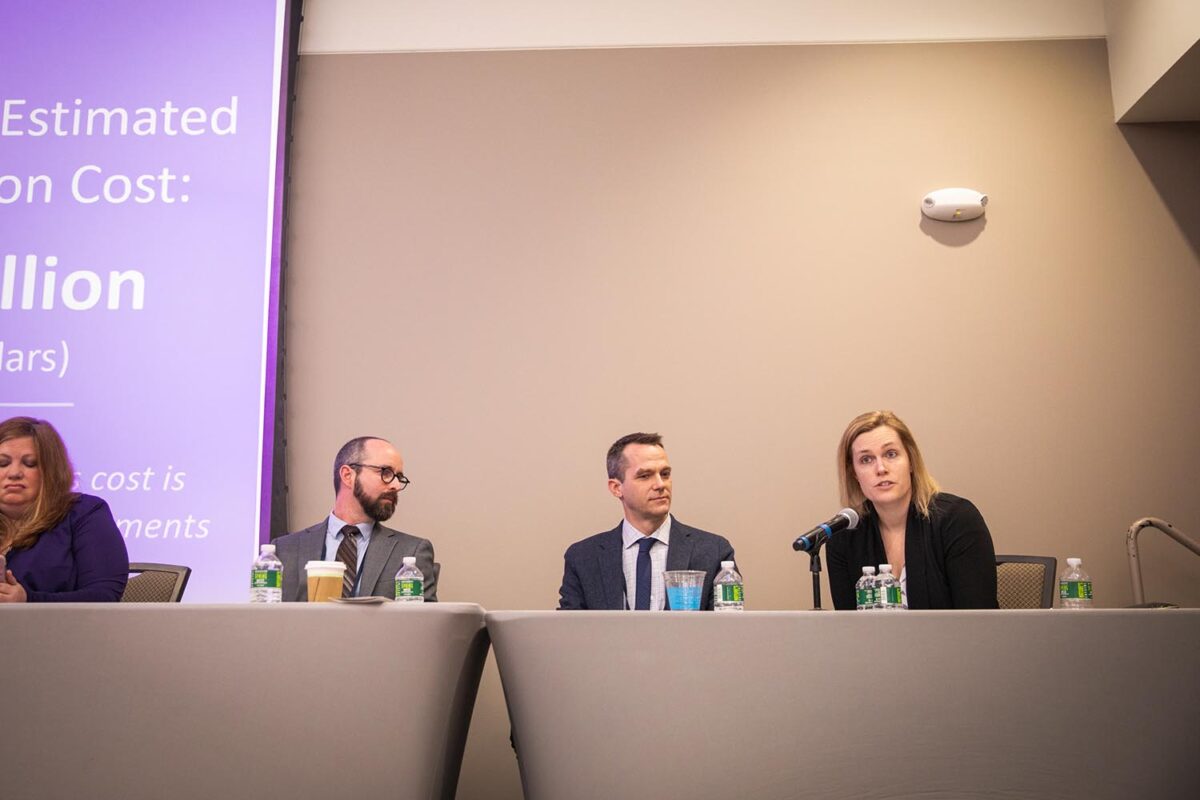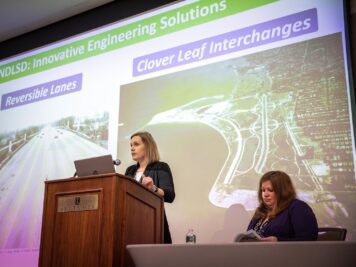
The North DuSable Lake Shore Drive Phase I Study seeks to redefine one of the most iconic roadways in America with the reconstruction of the drive between Grand and Hollywood Avenues within Lincoln Park in Chicago. Civiltech’s Jen Hyman, P.E., and Phil Hutchinson, PLA, were asked to give a presentation on this significant project at the 2024 Illinois Transportation and Highway Engineering (T.H.E.) Conference, held in Champaign, IL in late February. The annual conference brings together over one thousand Transportation Engineers, officials, technicians, faculty, and students, providing a forum to discuss critical issues that impact the Illinois transportation network.
Jen and Phil were joined by Dave Miller, with the Chicago Department of Transportation, and Kimberly Murphy, with the Illinois Department of Transportation, presenting, “North DuSable Lake Shore Drive Project Overview.” Kimberly introduced the presentation and speakers, then turned the podium over to Jen who presented on the background of the project and significant project components.
A Rich and Complex History
Jen is Civiltech’s Director of Design and Environmental Studies and has led the complex federal review processes for the North DuSable Lake Shore Drive (NDLSD) Study. In this presentation, she shared the historic significance and resulting challenges of this complex project. 
Renowned urban planner Daniel Burnham envisioned NDLSD (or simply, the “Drive”) as a “boulevard through a park” which was reflected in his Plan for Chicago to expand the City’s park and boulevard systems. As Lincoln Park grew on lake fill in Lake Michigan, so too did NDLSD. The development of Lincoln Park, the Drive, and the urban communities on Chicago’s north side in the early 1900s all play part in Lincoln Park’s listing on the National Register of Historic Places, with NDLSD as a contributing feature to the historic character of the park. Over time, the Drive grew to an 8-lane, grade separated facility to accommodate rising use of automobiles traveling from northern suburban communities to the City’s business district. Jen’s presentation touched on innovative engineering solutions that were part of the original drive, including reversible lanes and America’s first cloverleaf interchanges.
Read more about the history of NDLSD and Civiltech’s work on the required Federal Processes:
https://civiltechinc.com/capturing-history-section-106-historic-properties-identification-report-for-north-dusable-lake-shore-drive/
https://civiltechinc.com/diving-deep-into-history/
Jen then presented on current usage data sharing that NDLSD is now a transit-rich corridor accommodating 3,300 CTA bus trips carrying 69,000 passengers a day. The Study includes addressing challenges to improve transit access and function on NDLSD. In addition, parallel to the Drive is the busy Lakefront Trail serving up to 30,000 daily users on peak summer days. Jen explained deficiencies in the existing pedestrian and bicycle access and design improvements being studied to improve safety, usability, and equitable access.
Jen presented the additional challenges of the heavy vehicular traffic and access points that cause delays, safety deficiencies and crash history, and infrastructure deficiencies. The Drive’s infrastructure, including its many bridges and sections of road they carry, are over 90 years old and in need of repair.
Also, the adjacent Lake Michigan shoreline deficiencies cause storm-related erosion and damage during heavy storm events.
In summary, Jen presented the overarching Study goals include improving safety for all users, improving mobility for all users, improving access and circulation, and addressing infrastructure deficiencies. The goals are being addressed through proposed improvements to transit, the Lakefront Trail, the roadway and infrastructure, park space, and shoreline protection. Read more about the study of improved shoreline protection measures and climate resiliency as part of the NDLSD Study, including shoreline modeling here:
https://civiltechinc.com/quiet-on-the-set-capturing-the-ndlsd-shoreline-protection-studies-in-video/
Bringing the Wow Factor
Phil leads Civiltech’s Landscape Architecture department and Digital Rendering Team. Phil and his team have developed robust images illustrating the design ideas and opportunities along NDLSD. His portion of the presentation included a rich and engaging series of before and after images, utilizing before photos at significant study locations within the project limits and exciting digital renderings showing potential future conditions. Other Civiltech staff in attendance shared that the energy in the room increased and the audience buzzed with excitement when Phil advanced his presentation from an existing conditions photo to an “after” rendering.
CDOT’s Dave Miller wrapped up the presentation with a discussion of the NDLSD Public Engagement that has occurred to date. This includes extensive public meetings, task force meetings, community meetings, and stakeholder meetings. The project is also promoted through a robust website, NorthDuSableLSD.org, newsletters, and electronic updates. Dave closed with information on funding and anticipated construction costs and schedule.
A Meaningful Opportunity
When asked what they enjoyed most about the opportunity to give this exciting and meaningful presentation, Jen stated that she enjoys sharing the rich history of the Drive and Lincoln Park and the complexities of the project. She also enjoyed using the project detail and backstory to set the stage for Phil to present the “cool stuff” and excite the audience.
Phil shared that it was a rewarding experience and exciting to present such a high profile project to professionals in the Transportation Engineering field. He said he was grateful for the opportunity to show off all of the hard work that the NDLSD team has put in over the last 10 years.
.
